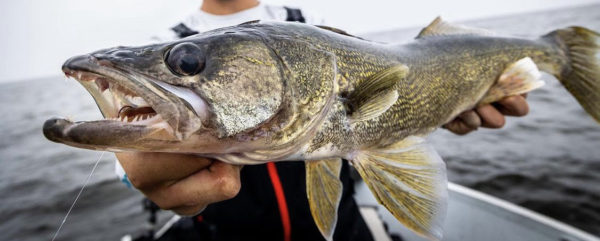How to Catch and Cook Walleyes this June
Category: article
Jun 2nd, 2022 by Keith Worrall
Modified Jun 2nd, 2022 at 3:21 PM
Snap Jig Your Way to Fresh Fish in the Pan
By Dr. Jason Halfen
June is perhaps the most consistent month on the annual walleye action calendar. The stressful spawn period is in the rearview mirror, and fish are settling into their summer patterns. Waters continue to warm into the low 70s, activating the entire food web – from insect larvae to suckers and everything in-between. Unstable spring weather has evolved into a more consistent rhythm that is easier on both walleyes and the anglers that target them. June is a great time to get bites – lots of them – and nothing beats the fun of filling the livewell with eater walleyes while snap jigging.
The snap jigging presentation taps directly into the walleye’s hyper-predatory DNA. By saturating the strike zone with aggressive, erratic lures – first darting several feet off the bottom, then plunging vulnerably back down – anglers can convert even casual lookers into impulsive biters. If you’re anxious to invite a few walleyes over for dinner this June, snap jigging belongs in your bag of tricks.
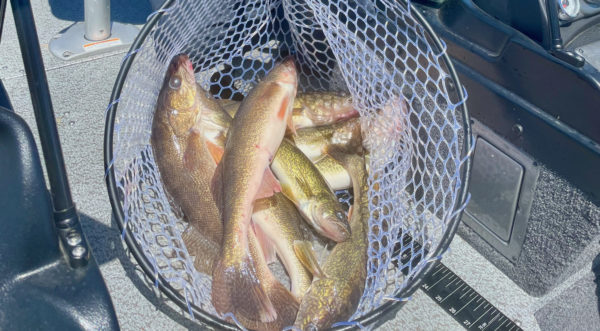
Let’s begin with the lure. In my boat, snap jigging is the nearly universal domain of soft plastics. Four- to five-inch split tail minnows or paddletail minnows get positions in my starting lineup. I favor soft, supple plastics with a lot of action over thick or stiff ones. Most of the lakes I fish have reasonable water clarity, so it should be no surprise that I hang a lot of white, grey, and purple colors – including their various combinations – on my jigs. If your walleye haunts are stained or turbid, fold in some chartreuse bodies or tails for additional visual appeal. Using the right jig will result in many more bites. The best jigs have long-shank, wide-gap hooks with a wire plastic keeper along the hook shank to keep the soft bait pinned tight to the jighead. When fishing most eight- to fifteen-foot deep waters, a ¼ oz jig will get the first call; step up to a ⅜ oz jig for fishing deeper or when dealing with a breezy walleye chop.
Just as with your jig choice, selecting the right combination of rod, reel, line, and leader can make the difference between a mouth-watering walleye meal and an overcooked convenience store hot dog from the roller grill. Choose a light, sensitive rod between 6’8” and 7’4” in length, with Medium power and Fast or Extra Fast action. Such a rod won’t tire you out after a losing day of snappin’, and will have the right combination of backbone power and tip flex that translates rod action directly into bait motion. There is perhaps no better choice for the serious snap jigger than the G. Loomis NRX+ 852S JWR: a 7’1”, incredibly light, extremely sensitive rod with Medium Power and Extra Fast action. Rig your rod with a comparably light, 2500-series spinning reel. My G. Loomis NRX+ is equipped with a Shimano Vanford VF2500HGF: a 6.3 oz powerhouse of a spinning reel that features Shimano’s light, rigid CI4+ body and exclusive MagnumLite Rotor which cuts rotational inertia in half compared to traditional rotor designs for ultra-quick responsiveness. Spool up with 15-pound-test hi-vis braided line, like PowerPro Super8Slick V2, and finish with a six-foot leader of 12-pound-test fluorocarbon.
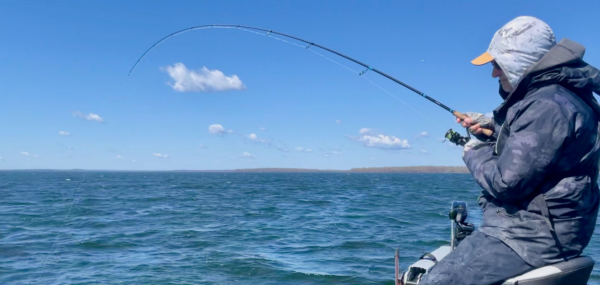
Two places to consistently find June walleyes – places that are perfect for snap jigging – are deep weedlines and the top and bottom edges of rocky bars and reefs. While your lake may be full of these features, focus your snappin’ time on those structural elements that are catching the wind. A nice breeze is good; a stiff wind is even better. Wind and wave action in these locations stir up the bottom, get the weeds swirling around, and make it harder for baitfish to hide from predators. Millenia of evolutionary pressures have taught modern walleyes that such conditions are the fastest ways to fill their bellies – and fill them, they will. These are the wrong places to be a shiner.
Begin by making a long cast with your jig-and-plastic combo; a smooth, eight-strand braided line will help. Let the jig hit bottom, then reel up slack line and pop the jig off the bottom with a sharp snap of the rod tip, say from the 10-o’clock position to 12-o’clock. Allow the lure to return to bottom on a relatively tight line; when the line goes slack, reel up the extra line with a couple of turns of the handle and repeatedly snap your way back to the boat. The vast majority of June walleye attacks occur as the lure plunges back to the bottom; you’ll often detect these strikes as a sharp tap that travels up the line, through the rod blank, and into your hand. The right leader, line, reel, and rod make it easy to tell the difference between a walleye strike and contact with a weed or a rock, and to know when your jig has traveled from an area with hard bottom to one that is muddy and soft. While snap jigging is a very aggressive presentation, don’t overlook the importance of how each component contributes to the sensitivity of the entire tackle system; every serious walleye angler knows that more sensitivity equals more success.
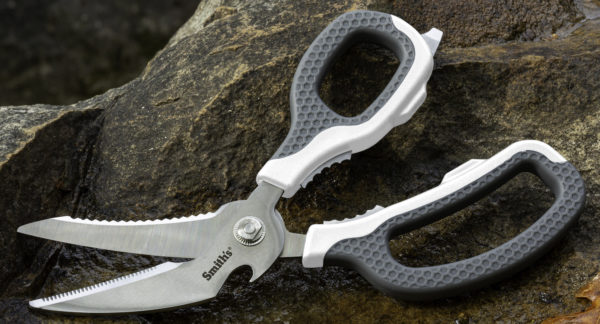
Plan ahead if you’re going to invite June walleyes over for dinner by bleeding the fish out in your livewell, and then getting them onto ice as soon as feasible. A stout pair of shears, like the Edgesport Bait and Game Shears from Smith’s Consumer Products, makes this process quick and easy. Keep the livewell pumping as the fish bleed, and then toss them into a cooler loaded with ice. Nothing ruins a walleye dinner faster than soft, spoiled fillets.
Two knives accompany me – and my finned guests of honor – to the cleaning table: Smith’s Lawaia Electric Fillet Knife and Smith’s Edgesport 6” Boning/Fillet Knife. The Lawaia electric knife makes quick work of fillet, skin, and bone removal, effortlessly handling the bulk of the fish processing. The Edgesport fillet knife gets the call for fine-detailed work, eliminating stowaway skin and bones in my finished fillets – especially the pin bones that run along the walleye’s lateral line.
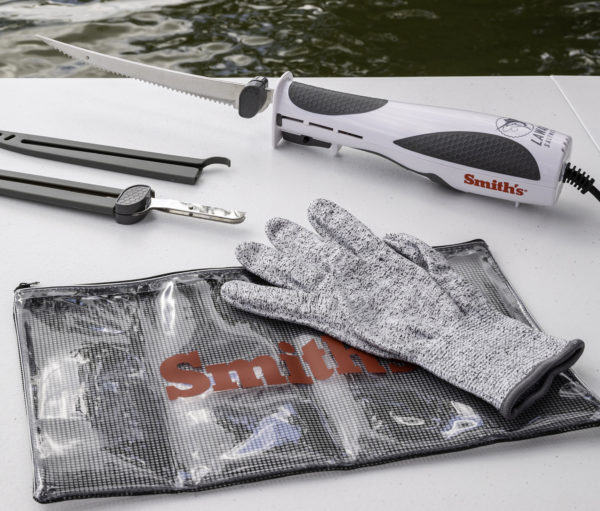
Perhaps my favorite way to enjoy June walleye is to blacken those fillets, Cajun-style. Preparing fish to blacken is easy: drizzle them with olive oil or grapeseed oil, and generously coat one side of each fillet with your favorite blend of Cajun spices; you’ll season the other side while they cook. Then, get the pan or griddle ready. The most important aspect of blackening fish is heat – that pan needs to be HOT to sear the outside of the fillets without drying out the interior. The RMP MOwok Collapsible Grill makes this process quick and easy. The extremely portable MOwok sets up in mere seconds and features a 10,000 BTU burner powered by a convenient, portable 1-pound propane cylinder. The MOwok’s steel disc pan is shaped like a wok and really soaks up the burner’s heat – perfect for frying up a thick steak or blackening the catch-of-the-day. Bring the pan up to temperature and then add the fillets, seasoned-side down, starting in the middle of the pan and working your way out. While they cook, generously season the sides that are facing up with your Cajun spice mixture. Blacken the first side for 4 or 5 minutes, depending on the fillet’s thickness, and then flip to blacken the other side, which will heat for a similar length of time as the first. Enjoy your blackened June walleye hot from the pan, complemented by crisp coleslaw, a salad of fresh Roma tomatoes, thick-sliced cucumbers and sliced red onions in a sweet vinaigrette dressing, and fresh bakery rolls with plenty of butter: a meal fit for a king!
June is a great time to catch a pile of walleyes and enjoy a terrific meal of North America’s most delicious freshwater fish. Enjoy this abundance now, before the slow dog days of summer arrive!
